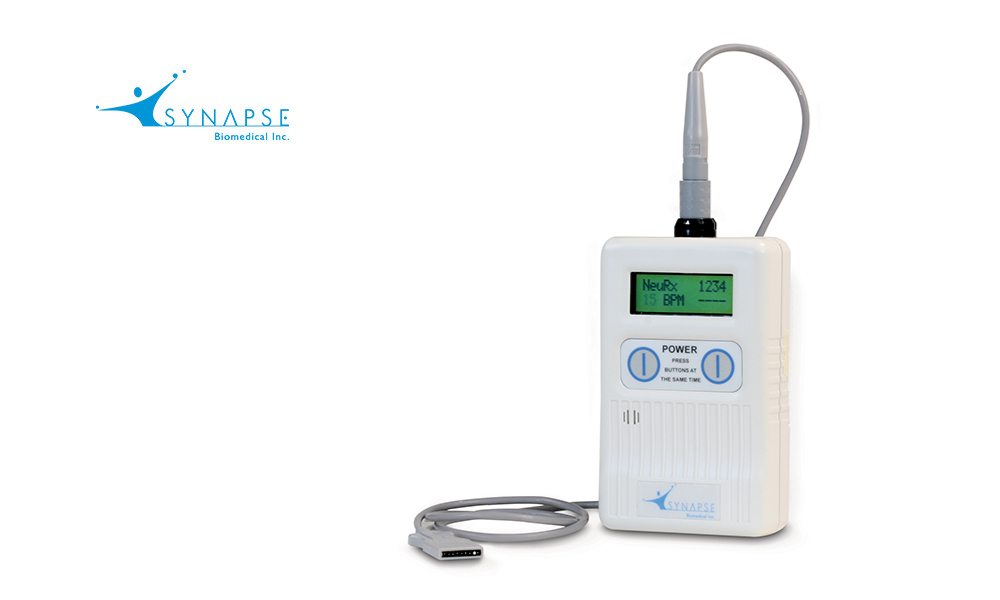Diaphragm Stimulator for SCI

NeuRx® Diaphragm Pacing
The NeuRx® Diaphragm Pacing System is designed as an alternative treatment for patients with spinal cord injuries that result in the reliance on a ventilator to breathe.
Initially in a patient suffering from a spinal cord injury, the stimulation from the NeuRx® DPS works to condition their diaphragm muscle, which has weakened from a lack of use due to their injury.
In Synapse BioMedical’s clinical trial of 50 high-level spinal cord injury / quadriplegia patients implanted with the NeuRx® DPS.
- 100% success rate in achieving tidal volumes in patients with intact phrenic nerve.
- 25 patients achieved full-time diaphragm pacing and eliminated the use of their ventilator.
- 33 patients paced more than 12 hours per day and significantly reduced the time spent on their ventilator.
- Reduce and in some cases eliminate their dependency on mechanical ventilators
- Regain their independence by enhancing their mobility and transportation options
- Allow them to sleep more comfortably and soundly without constant ventilator noise
- May allow for natural breathing through the nose and mouth rather than primarily through tracheostomy tube
Patient Information
What is the NeuRx Diaphragm Pacing System™ and how does it improve the way an SCI patient breathes?
Unlike a mechanical ventilator, the NeuRx DPS™ provides a gentle, rhythmic, electrical stimulation to your diaphragm, causing it to contract. Initially in an SCI patient, this stimulation works to exercise and strengthen your diaphragm muscle, which had weakened while you were on a ventilator. You will begin taking deeper breaths for longer periods of time. With the assistance of the NeuRx DPS™, the breaths you take are similar to a natural, comfortable breathing pattern. This enables many SCI patients to regain their sense of smell and taste. The system can achieve long-term replacement of positive pressure mechanical ventilation for SCI patients with intact phrenic nerves.
The NeuRx DPS™ consists of:
- Four electrodes implanted in the diaphragm
- A fifth electrode to complete the electrical circuit
- A connector holder
- A cable
- A small, external, battery-powered pulse generator
Your caregiver controls the NeuRx DPS™ and can turn the device on and off when you choose. When it is off for extended periods, you will likely need to return to positive pressure ventilation support. The settings are defined by a trained clinician and can only be adjusted by them. The easily-concealed pulse generator provides stimulus timing and control in order to regulate movement of your diaphragm and optimize respiration.
How is the NeuRx DPS™ implanted?
What happens after surgery?
Prior to discharge, you will receive specific conditioning instructions from your care team. You may be instructed by your physician not to use the NeuRx DPS™ right away to allow your body time to heal from surgery.
The initial conditioning sessions last as long as you can tolerate being off the ventilator, which depends on how weak your diaphragm is. During a conditioning session, your caregiver will turn on the NeuRx DPS™ and then remove you from the ventilator. Your caregiver will measure your oxygen level with a finger clip on a pulse oximeter or may measure the amount of air you are breathing with a handheld device called a Wright Respirometer. A pulse oximeter and Wright Respirometer are not essential to conditioning and may not be available in your payer plans. You should check with your insurance provider.
Your care team will instruct you on the number and duration of your conditioning sessions. To maximize your progress, record the time you remain on the pacing system at each session.
How do I know the NeuRx DPS™ will work for me?
of the laparoscopic procedure. The diaphragm has to move with stimulation for the NeuRx DPS™ to be effective.
What is the NeuRx Diaphragm Pacing System’s® proof of performance?
What NeuRx DPS® Patients Are Saying
The Pacer has changed my life tremendously. I haven’t had a single problem with the pacer and it has for sure given me a better quality of life. – Adam Booker
The pacer has allowed me to do many things that I never thought I would be able to do again. It really has enhanced my life. – Heather Johnson
Without having tubes on my chest and not hearing the constant noise from the ventilator, I feel much more like a person and less like a machine. – Joel Vander Molen
The competent and compassionate service that I have received from this company is exemplary. Thank you, Synapse, for giving me my life back. – Nicholas Essis
INTENDED USE
The NeuRx™ RA/4 is intended for use in patients with stable, high spinal cord injuries with stimulatable diaphragms, but who lack control of their diaphragms. The device is indicated to allow the patients to breathe without the assistance of a mechanical ventilator for at least 4 continuous hours a day.
